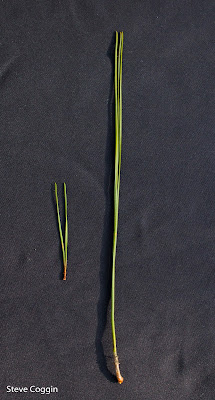 |
| A Zebra Longwing (Heliconius charithonia) feeding on Spanish Needles (Bidens pilosa). Palm Beach County, Florida |
Think of Florida as a limestone shelf that dives 400 miles south toward the tropics. In north Florida, you find swamps and forests that could be in Louisiana or North Carolina. At the southern end of the peninsula, natural areas can resemble Belize or Brazil. Many tropical plants and animals find the northern limit of their range in the subtropical climate of Florida including some interesting butterflies.
 |
| White Peacock (Anartia jatrophae). Palm Beach County, Florida. |
The White Peacock (Anartia jatrophae) is a common tropical butterfly in Florida. This handsome insect is white with orange and brown markings and black spots on the wings. Host plants for the larvae of White Peacocks include several species of Verbena. White Peacocks are found in open fields and fly close to the ground. Male White Peacocks are territorial and vigorously defend their patch of prime habitat. This butterfly lives throughout Florida, along the Gulf coast and through Mexico to the tropics.
 |
| Julia (Dryas iulia) feeding on Spanish Needles flowers. Palm Beach County, Florida. |
One of the most beautiful Florida butterflies is the Julia (Dryas iulia). Julias have long, bright orange wings with black spots. They are found throughout South and Central America, the Caribbean, and extend their range into South Texas and South Florida. Julias lay their eggs on passionflowers (Passiflora sp.) and feed on the nectar of many flowers.
 |
| A Julia drinking the nectar of Late Boneset (Eupatorium serotinum). Palm Beach County, Florida. |
The Ruddy Daggerwing (Marpesia petreus) is another large, orange, tropical butterfly that lives in South Florida. Their wings have black stripes and dagger-like tails that give this butterfly its name. Ruddy Daggerwings often land on plants with their heads facing down. The host plants for Ruddy Daggerwing larvae are figs (Ficus sp.) so this butterly’s range is limited by the availability of these trees.
 |
| A Ruddy Daggerwing (Marpesia petreus) showing off its orange and black wings with dagger tails. This Daggerwing is feeding on Spanish Needles. Palm Beach County, Florida. |
 |
| A Ruddy Daggerwing perched on a dead Cabbage Palm (Sabel palmetto) frond. This Daggerwing has adpoted its typical head-down pose. Palm Beach County, Florida. |
Zebra Longwing (Heliconius charithonia) is an iconic tropical butterfly. Its long black wings are decorated with bold yellow stripes. Zebra Longwings live along forest edges where they feed on a variety of flowers. Jeffery Glassberg, in his book Butterflies through Binoculars: the East, describes Zebra Longwings as “Flying slowly and gracefully, usually in the dappled light of semi-shade”. The Heliconian butterflies, of which the Zebra Longwing is a member, are unique because they feed not only on nectar but also on pollen. The pollen of some flowers make the Zebra Longwing unpalatable to predators and the yellow and black coloration advertises this fact. Zebra Longwings lay their eggs on Passionflower plants and can raise several broods per year. During the warm months, Zebra Longwings wander and show up as far north as Colorado and Maryland.
 |
| A Zebra Longwing sipping nectar from Tasselflower (Emilia fosbergii). |
Florida,
with its mild climate has many naturally occurring tropical species. But, it has also become the home of many introduced plants
and animals, some of which are invasive and highly destructive. White Peacocks, Julias, Ruddy Daggerwings and
Zebra Longwings are all tropical species that are native to Florida and are essential
parts of this sub-tropical ecosystem.
 |
| A White Peacock watching over its territory. Palm Beach County, Florida. |












